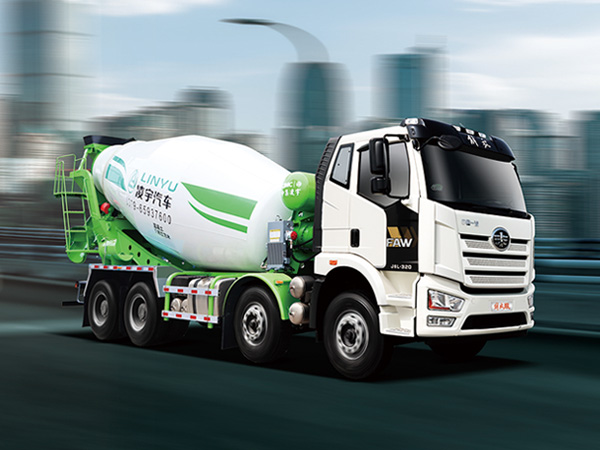As a critical piece of transportation equipment in construction, safe operation and proper maintenance of concrete mixer trucks are crucial for ensuring construction progress, extending vehicle life, and ensuring personnel safety. The following provides detailed information on safe driving techniques and daily maintenance for concrete mixer trucks.
I. Safe Driving Techniques for Concrete Mixer Trucks
(I) Pre-Driving Preparation
1. Comprehensive Vehicle Inspection: Walk around the vehicle to check for damage, tire pressure, and screws. In particular, check the mixer tank connections. Also, check the brake fluid level and brake pad wear to ensure proper braking. Check the lighting system to ensure the headlights, turn signals, and brake lights are functioning properly.
2. Familiarize yourself with the transport route: Plan your route in advance to identify any construction sites, curves, or steep slopes, and avoid congested areas. Use map software or consult a local driver to assess road conditions.
3. Adjust your driving posture: Adjust your seat so your feet can easily operate the clutch, brake, and accelerator. When steering with both hands, your arms should be naturally bent and able to operate components flexibly. Adjust your rearview mirrors to minimize blind spots. (II) Driving Operations
1. Control Speed and Safe Distance: A concrete mixer truck is heavy and the concrete is in motion. Maintain a speed of 40-60 km/h on ordinary roads, and slow down in advance at curves and intersections. Maintain at least twice the distance from the vehicle in front of you to prevent rear-end collisions.
2. Smooth Turns and U-Turns: Turn your turn signal and steer slowly before turning to avoid sudden turns that could cause the vehicle to overturn. Make U-turns in a spacious area, using reverse if necessary.
3. Avoid Sudden Braking and Acceleration: Sudden braking and acceleration can cause the concrete inside the tank to sway, damaging the tank structure and affecting driving stability. Anticipate road conditions and accelerate and decelerate smoothly.
(III) Dealing with Special Situations
1. Driving in Inclement Weather: Reduce speed in rainy weather, use fog lights and low beams, and avoid deep water. Install anti-skid chains on snowy or icy roads, slow down, and maintain safe distance between vehicles. 2. Driving on the construction site: Slow down upon entering the construction site, follow the designated route, and avoid construction areas and other vehicles. Pay close attention to surrounding conditions when turning or reversing, and seek guidance from a designated person if necessary.
3. Emergency Fault Handling: In the event of a vehicle breakdown, move to a safe area, activate the hazard lights, and display warning signs. Initially identify the problem; if the problem cannot be resolved, call for assistance.

II. Daily Maintenance Key Points for Concrete Mixer Trucks
(I) Body and Chassis Maintenance
1. Body Cleaning: After transport, promptly clean the body with a high-pressure water gun and special car wash fluid to remove concrete, dirt, and other dirt to prevent corrosion on the paint and structure.
2. Chassis Component Inspection: Regularly inspect suspension, transmission, and steering system components, such as springs, shock absorbers, drive chains, and steering rod joints. Repair or replace any problems promptly.
3. Chassis Component Lubrication: Regularly lubricate lubrication points such as the drive shaft universal joint, steering knuckle, and brake cylinder to reduce component friction. (II) Mixing Tank Maintenance
1. Cleaning the Mixing Tank: At the end of each day, add clean water, start the mixing mechanism, and rinse it. Then, flush it with a high-pressure water jet to prevent any hardened concrete residue.
2. Checking the Mixing Blades: Regularly inspect the blades for wear. Replace them if wear exceeds one-third of their original thickness. Tighten the connection between the blades and the tank.
3. Maintaining the Mixing Tank Drive System: Regularly check the oil level and quality of the reducer, and inspect the coupling bolts and hydraulic pump for leaks to ensure proper operation of the drive system.
(III) Engine Maintenance
1. Changing the Engine Oil and Oil Filter: According to the engine manual, change the engine oil and filter every 5,000 to 10,000 kilometers to ensure proper engine operation.
2. Checking the Air Filter: Regularly inspect the filter element and clean or replace it if dirty. Change it more frequently in dusty environments. 3. Cooling System Maintenance: Regularly check the coolant level, inspect the pipes for leaks, and clean the radiator to ensure proper heat dissipation.
Safe operation and routine maintenance of concrete mixer trucks require a high level of responsibility and professional knowledge from the driver. Strictly adhering to safe driving regulations and performing routine maintenance can effectively improve vehicle safety and reliability, providing a strong guarantee for the smooth progress of construction.
